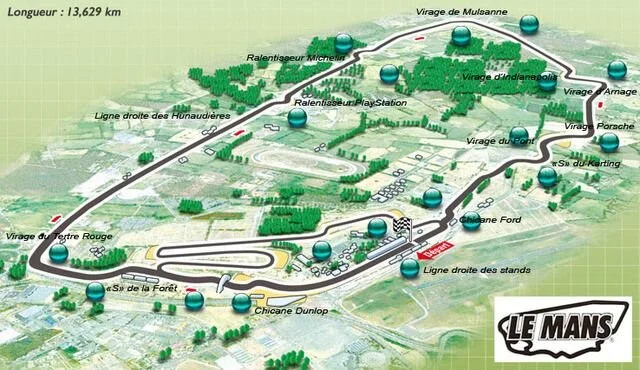Le Mans - The Ultimate Endurance Test
A Profile of Le Mans: Home of the 24-hour race
Requiring the perfect blend of speed and reliability, the Le Mans Circuit is one of the world’s most iconic sports venues, and the track used exclusively for the 24 Hours of Le Mans race - the most historic endurance race in motorsport.
Charlie Widdicombe details the track, the history and the general vibe of Le Mans, home of the 24-race, motorsports’ toughest challenge.
The Icon Les Mans 24 hours
The Le Mans Circuit
Also known as the Circuit de la Sarthe, the original Le Mans Circuit consisted entirely of public roads and was first raced in 1920 as the French Grand Prix, before becoming the inaugural 24 Hours race in 1923.
In its first race, which was dominated by French cars and drivers, the circuit was a sizeable 17.2km in length including the infamous 8km Mulsanne straight.
Since then the circuit has undergone significant changes, now boasting 38 corners rather than the original 12 turns, and has been shortened to 13.6km. Although some of its most famous corners such as the Porsche curves and Ford Chicane were added in 1972, and further changes have been made, many aspects of the track have only undergone minor re-profiling from the inaugural race, including the Indianapolis, Arnage and Tetre Rouge corners.
The nature of the circuit has changed very little, with focus remaining on reducing drag to benefit from the long straights, fast corners and heavy braking zones.
A diagram of the Le Mans circuit
The Le Mans Circuit is now a mixture of a purpose-built race track and public roads, which are closed off annually for the 24 Hours event to take place. However, the Bugatti Circuit is a permanent track residing within the confines of Le Mans, using part of the 24-hour circuit and a separate, purpose-built section.
This track regularly hosts Moto GP and has also hosted F3000, DTM, and one occasion back in 1967, a Formula One race.
Traditions and protocols of the Le Mans 24 Hours
The Le Mans 24 Hours forms part of Motorsport’s heralded ‘Triple Crown’, alongside the Monaco Grand Prix and the Indy 500.
It was Le Mans that formed the final piece of the puzzle for Graham Hill, who sealed the first and only triple crown to date by winning the 1972 race.
The race also forms part of the World Endurance Championship, under which there are four different classes of car that compete. LMP1 and LMP 2 are prototypes built specifically for Le Mans, with the latter requiring at least one ‘amateur’ driver (judged by the FIA’s grading system) and the same engine as their competitors. GT Pro and GT am are adapted versions of on-sale road cars, with GT am requiring at least two of each driver line-up to be ‘amateurs’.
Nowadays each car is required to have 3 drivers, each driving for a minimum of 6 hours and 14 maximum.
Such procedures weren’t always in place, and in 1950 Louis Rogier drove for the entirety of the race, except for 2 laps in which his son briefly filled in. Rogier Snr managed to grab a comfort break and some food before returning to the car and proceeding to dominate the rest of the race in a truly astonishing feat of sporting endurance.
One of Le Mans’ best-known traditions is the now-defunct start procedure.
At the waving of the French Tricolore flag, each driver would have to run across the track to their car and fasten their seat belts before setting off. The tradition was highly dangerous, with drivers often failing to fasten their seat belts in eagerness to set off, and was eventually scrapped for 1970 after Jacky Ickx walked across the track in protest at the start of the 1969 race before going on to win.
Nowadays the French Tricolore remains, but a rolling start provides a less exciting but much safer opening.
Jacky Ickx - Winning on track and off
Another unique challenge posed by the race is that during pit stops, the car’s engine must be turned off and restarted, adding another area in which the reliability of the car is tested. Only 4 mechanics can attend to the car at any one time, whilst only 2 wheel guns are permitted per car.
Tragedy and The Mercedes Curse at Le Mans
Sadly, the incredibly high-speed nature of the track has led to the death of 22 drivers in the Le Mans 24 Hours.
The Mulsanne straight is responsible for over half of these and two chicanes were added there for 1990 in the interests of safety.
The most deadly crash in motorsport history took place at Le Mans in 1955, when Mercedes driver Pierre Levegh launched off the back of another driver on the pit straight and hurtled into the crowd. The car’s magnesium body burst into flames, killing 83 spectators and Levegh himself. Mercedes withdrew from all forms of motorsport at the end of the year, not returning until 1989.
It was in 1999, with Mercedes back in the fold and the favourites to take the overall Le Mans victory, that the team was extremely fortunate to escape further incident.
In 3 separate incidents in qualifying, warm-up and the race itself, the car quite literally took off and somersaulted in the air, due to aerodynamic instability that was worsened when coming over a crest in the road, or in the slipstream of another car.
Mark Webber, twice, landed back on the circuit, but Peter Dumbrek flew over the guardrail and the car was pierced by a nearby tree. Mercifully, neither Dumbrek nor the fuel tank were hit, but the incidents were enough for Mercedes to leave Le Mans once again - and they haven’t returned since.
Most Successful Constructors and Drivers at Le Mans
25 different constructors have taken the overall win at Le Mans, but Porsche are comfortably out in front, with 19 victories - despite only winning for the first time in 1970. Audi are second with 13 wins, all of which have taken place in the 21st century.
Porsche - Undisputed Kings of Le Mans
Ferrari and Jaguar, who dominated the 1950s and early 1960s between them, have 9 and 7 wins respectively - but with the recent announcement that Ferrari will be returning to Le Mans in 2023 with an all-new hypercar, they’ll be hoping to close up on Porsche over the next decade.
Toyota has won the last three races, exclusively with former Formula 1 drivers, including triple crown hopeful Fernando Alonso, who in fact returns to F1 with Alpine this season.
Driver Tom Kristensen is comfortably the most successful driver in Le Mans history with 9 victories between 1997 and 2013, with former F1 race winner Jacky Ickx the previous record holder with 6 titles.
Final Thoughts on Le Mans
Such is the prestigious nature of the Le Mans 24 Hours, the event supersedes the Le Mans Circuit and even the name of the city itself. The race is steeped in such arich history that it dwarfs other 24-hour events that take place at iconic circuits such as the Nurburgring, Spa- Francorchamps and Daytona - and it’s hard to imagine a time when Le Mans is not regarded as the absolute pinnacle of endurance racing.
Please do check out (and share) content from our growing Motorsport collection!










